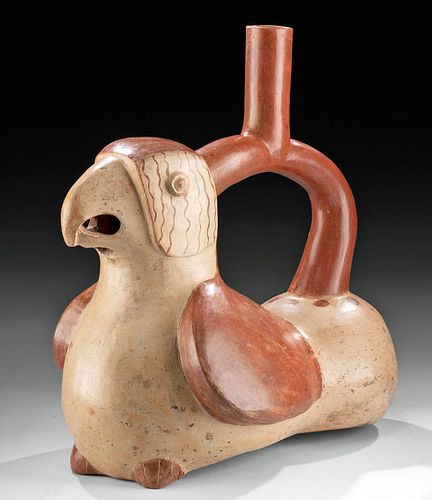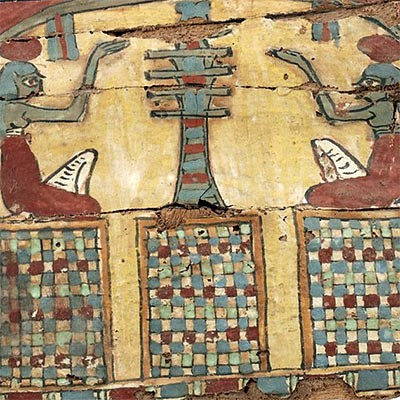Moche Bi-Chrome Whistling Stirrup Vessel Macaw, TL Test
Lot 88d
About Seller
Artemis Gallery
686 S Taylor Ave, Ste 106
Louisville, CO 80027
United States
Selling antiquities, ancient and ethnographic art online since 1993, Artemis Gallery specializes in Classical Antiquities (Egyptian, Greek, Roman, Near Eastern), Asian, Pre-Columbian, African / Tribal / Oceanographic art. Our extensive inventory includes pottery, stone, metal, wood, glass and textil...Read more
Estimate:
$2,400 - $3,600
Absentee vs Live bid
Two ways to bid:
- Leave a max absentee bid and the platform will bid on your behalf up to your maximum bid during the live auction.
- Bid live during the auction and your bids will be submitted real-time to the auctioneer.
Bid Increments
| Price | Bid Increment |
|---|---|
| $0 | $25 |
| $300 | $50 |
| $1,000 | $100 |
| $2,000 | $250 |
| $5,000 | $500 |
| $10,000 | $1,000 |
| $20,000 | $2,500 |
| $50,000 | $5,000 |
| $100,000 | $10,000 |
| $200,000 | $20,000 |
About Auction
By Artemis Gallery
Jul 30, 2020
Set Reminder
2020-07-30 10:00:00
2020-07-30 10:00:00
America/New_York
Bidsquare
Bidsquare : Ancient / Ethnographic From Around the World
https://www.bidsquare.com/auctions/artemis-gallery/ancient-ethnographic-from-around-the-world-5382
Ancient art from Egypt, Greece, Italy and the Near East, as well as Asian, Pre-Columbian, Native American, African / Tribal / Oceanic, Spanish Colonial, Russian Icons, Fine art, much more! All categories, all price ranges... all legally acquired and guaranteed to be as described or your money back. Artemis Gallery info@artemisgallery.com
Ancient art from Egypt, Greece, Italy and the Near East, as well as Asian, Pre-Columbian, Native American, African / Tribal / Oceanic, Spanish Colonial, Russian Icons, Fine art, much more! All categories, all price ranges... all legally acquired and guaranteed to be as described or your money back. Artemis Gallery info@artemisgallery.com
- Lot Description
Pre-Columbian, Central/North Coast Peru, Moche, Phase IV, ca. 450 to 700 CE. A gorgeous, hand-built pottery vessel with a planar base, a bulbous body with two chambers and a raised avian head atop the larger chamber, a semicircular, stirrup-shaped handle with a cylindrical spout in the middle. Depicted is a highly stylized macaw that forms much of the larger chamber, and the smaller chamber - replete with a red stippled ring - doubles as the bird's tail. The highly burnished vessel is first covered in cream-hued slip and accentuated with red pigment that forms the vermilion feathers, the pupils centered on the bulging eyes, the petite feet, and the handle and spout. A perforated tone hole within the macaw's mouth creates a fine sound when air is blown into the spout. Size: 8.75" L x 5.375" W x 9.3" H (22.2 cm x 13.7 cm x 23.6 cm)
Andean societies thought of birds as precious resources; there was a roaring trade, for example, in parrot and macaw feathers from the Amazon Basin to the Andes so that they could adorn the garments of elites. An immense variety of birds appears in ancient Andean artwork, often depicted in ways that both emphasized supernatural qualities they were believed to have but also showing that the artisans were familiar with what real birds of many species looked like. To the Moche, birds signified prestige, and the bright plumage of the macaw made it especially valuable.
Stirrup spout vessels reached their high point with the Moche culture, which flourished during the Early Intermediate period from approximately 100 BCE through 800 CE where a vast array and large quantities of these ceramics were produced. The Moche or Mochica employed a wide variety of techniques to create vessels ranging from the most basic and utilitarian to finely painted pots and carefully molded portrait vessels that display wonderful artistic expression.
This vessel has been tested using thermoluminescence (TL) analysis by Ralf Kotalla Thermoluminescence Laboratories, Germany, ref. no. 549404 (May 30, 1994). A full report will accompany purchase.
Provenance: ex-private Hans Juergen Westermann collection, Germany, collected from the 1950s to the 1960s
All items legal to buy/sell under U.S. Statute covering cultural patrimony Code 2600, CHAPTER 14, and are guaranteed to be as described or your money back.
A Certificate of Authenticity will accompany all winning bids.
We ship worldwide and handle all shipping in-house for your convenience.
#153230Professionally repaired from multiple pieces, with restoration in some areas, and resurfacing and overpainting along new material and break lines. Abrasions and minor nicks to base, both chambers, macaw head, handle, and spout, with fading and chipping to areas of original pigmentation, and light encrustations. Nice traces of original pigment throughout. Whistle produces nice sound when played. Two TL drill holes: one beneath one foot, and one behind head.Condition
- Shipping Info
-
All shipping is handled in-house for your convenience. Your invoice from Artemis Gallery will include shipping calculation instructions. If in doubt, please inquire BEFORE bidding for estimated shipping costs for individual items.
-
- Buyer's Premium



 EUR
EUR CAD
CAD AUD
AUD GBP
GBP MXN
MXN HKD
HKD CNY
CNY MYR
MYR SEK
SEK SGD
SGD CHF
CHF THB
THB















